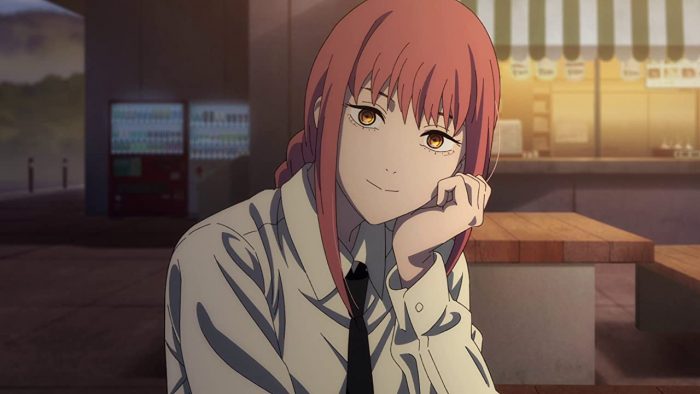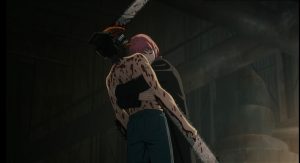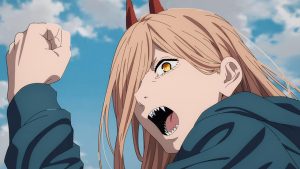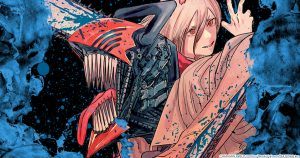
On almost any Western anime website, you’ll find dozens of articles praising MAPPA’s 2022 adaptation of Chainsaw Man—including right here, on Honey’s Anime.
Bloody, bombastic, and boldly inspired, Chainsaw Man’s anime was universally beloved by Western audiences. From workplace banter to juvenile humor followed by emotional gut punches, Fujimoto Tatsuki’s work incorporates his trademark nihilism with the sad hopefulness of a young man who’s known nothing but cruelty.
At the time of writing this article, Chainsaw Man’s anime holds a mind-blowing 100% recommendation rating from critics on review aggregator Rotten Tomatoes, matched with an audience score of 88%. Westerners absolutely loved Chainsaw Man, but across the ocean, Denji’s story failed to resonate with Japanese audiences.
In its first-week Blu-Ray sales (the most prominent metric for an anime’s success in Japan), Chainsaw Man sold just 1,785 copies. Compare that with Demon Slayer: Kimetsu no Yaiba’s first-week sales of 41,379, or MAPPA’s own Jujutsu Kaisen, which netted 35,040 sales during its first week.
And the Blu-Ray sales are just the tip of the iceberg for Chainsaw Man’s slew of problems with the Japanese fan base. Join us today on Honey’s Anime as we answer the question—Why Did Chainsaw Man’s Anime Fail in Japan?
A Recipe for Success
First, let’s take a step back.
Chainsaw Man is Fujimoto’s second serialized manga, following hot on the heels of Fire Punch, a dark supernatural thriller that takes place on a post-apocalyptic, frozen Earth. The eight-volume series was received well, but nothing could prepare Fujimoto—or the manga world—for his next series.
As of January 2023, Chainsaw Man has a staggering 23 million copies in circulation—making it not only one of the best-selling manga in history, but handily beating other dark-fantasy shounen manga like Enen no Shouboutai (Fire Force) and Monster, and putting it close behind Ao no Ekusoshisuto (Blue Exorcist).
In Japan, Chainsaw Man took home the 66th Shogakukan Manga Award for shounen in 2021, while in the West, it secured the Harvey Award for Best Manga in both 2021 and 2022.
Despite Fujimoto’s rough artwork and overwhelmingly bleak narrative, his work has been hugely popular with audiences. By all accounts, the anime adaptation of Chainsaw Man was a given—the very definition of a “sure thing.” And yet, after just the first episode, the internet was quick to react, lambasting MAPPA’s director Nakayama Ryuu for his approach to the adaptation.
So, what was it about the adaptation that disappointed Japanese audiences?
A Clear Direction
Nakayama made his directorial debut with Chainsaw Man, after having worked as an Episode Director on various other shows.
In a December 2022 interview with Famitsu, Nakayama reiterated his desire to express—in his own words, “the essence of the original work” and praised the “unfathomable wonder” of Fujimoto’s works.
Nakayama clearly had the best intentions when it came to his vision for the project. In fact, Fujimoto was heavily involved with the anime adaptation, and according to the manga’s editor, Lin Shihei, Fujimoto was in close contact with MAPPA, and was involved in pitches, story structure, scripts, and even storyboards.
Still, Japanese fans were quick to attack the slow-paced nature of the anime adaptation, while MAPPA faced complaints over their usage of CGI, and their deviation from some memorable character expressions.
The Japanese audience were also upset with the choice to cast rookie voice actor Toya Kikunosuke for Denji, with most fans pushing for the star-studded Okamoto Nobuhiko instead—best known for his roles in Toaru Majutsu no Indekkusu (A Certain Magical Index) as Accelerator, My Hero Academia as Katsuki Bakugou, and Horimiya as Kakeru Sengoku.
With negative feedback piling up, Fujimoto himself made the unusual choice to respond on Twitter, praising the anime to help allay some concerns. His Twitter account usually role-plays as a “little sister” in elementary school who loves Fire Punch and Chainsaw Man—and Fujimoto rarely breaks character.
It’s hard to imagine this was anything other than an attempt to put the brakes on the mounting criticisms.
Chainsaw Man’s adaptation did more than just play with the pacing, however. In a bold move, MAPPA commissioned twelve different ending songs and animations, which Nakayama described as “very hard” but “worth doing” in his Famitsu interview.
There’s another facet to Chainsaw Man’s anime though—and one that more succinctly explains the vast differences in success between the Japanese and international markets.
Western Inspiration for a Japanese Show
Chainsaw Man’s opening has been widely praised for its structure and the many movie references and Easter Eggs hiding amidst quick transitions. Yet, it’s this very opening that perhaps signifies the anime’s greatest problem—appealing to a Western audience that wasn’t waiting at home.
Amongst others, Chainsaw Man’s opening pays homage to Reservoir Dogs (1992), Texas Chainsaw Massacre (1974), Pulp Fiction (1994), No Country For Old Men (2007), Once Upon a Time in Hollywood (2019), Fight Club (1999) and The Big Lebowski (1998). Neon Genesis Evangelion (1995) gets only a brief parody, as does Sadako vs. Kayako (2016).
There’s an overwhelming bias towards Western films here, and in particular, a disproportionate number of films directed by Quentin Tarantino—arguably one of Western filmmaking’s greatest, and most distinctive, directors.
In fact, many of MAPPA’s most poignant scenes seem to draw inspiration from Tarantino-esque framing and execution. Heavy usage of detailed background lighting, with a strong focus on overlapping character dialogue and small changes in expressions, are strong hallmarks of Western-inspired cinema.
In particular, Episode 8, which features the now-infamous “Execution Scene” perfectly exemplifies this Tarantino-style approach, with a slow musical number that gradually heightens the viewer’s sense of “something is wrong.”
Except, herein lies the problem—international audiences are, by their very definition, a secondary market to anime and manga. English translations and dubs are welcome and appreciated, but by no means an expectation nor requirement of the industry. Directors and authors in Japan should always be writing firstly for their home audience—and if it reaches success overseas, that’s an added bonus.
This isn’t a foreign concept, either.
If a Western film does poorly at the domestic box office, but succeeds internationally, there are no consolation prizes. Authors don’t take home the Hugo Award if their books do well in another language. Creative works are—at least in our current, modern society—chiefly deemed successful by their performance in their country of origin.
Chainsaw Man is the latest victim of misunderstanding that simple fact; and though we have no doubt the show will make plenty of money through licensing deals overseas, its Blu-Ray sales in Japan are, put frankly, woeful.
Perhaps we could end our discussion here, allowing the fault to sit with a new director and a fickle fanbase; an inspired approach to anime direction that didn’t quite stick the landing. And yet, that wouldn’t be telling the full story—because this is not the first time Studio MAPPA have disappointed their audience.
Chainsaw Man is just the latest in MAPPA’s long line of troubles.
A Studio Mired in Problems
It hasn’t been smooth sailing for MAPPA, not by a long shot.
In May 2021, freelance animator Mushiyo broke their silence in since-deleted Tweets (viewable here on Otakomu), deploring the working conditions at the studio. Despite MAPPA being founded in 2011 by Maruyama Masao to escape the corporate life of Madhouse, various complaints about overworking and low pay indicate that MAPPA has become the very thing it sought to destroy.
Even outside their own studio problems, MAPPA have struggled to properly engage with their audience.
Take, for example, the wildfire success of Yuri!!! On Ice. Fans have been left waiting seven years for a sequel that was announced but never produced. And let’s not forget the huge artistic changes that MAPPA brought to Shingeki no Kyojin (Attack on Titan) when they replaced WIT Studio in 2020.
In particular, fans complained about MAPPA’s handling of Attack on Titan’s release schedule when Season 4 was broken into three distinct parts rather than cours. In early January 2023, perhaps to draw attention away from Chainsaw Man’s failing sales, MAPPA announced that Part 3 of Attack on Titan’s “Final Season” would be broadcast in—you guessed it—two parts.
Twitter user @Graaffiti’s meme neatly sums up our thoughts on the matter.
All this is to say that MAPPA isn’t the best at listening to their fans and responding to feedback. After previous criticism for Attack on Titan’s schedule, surely they would have realized the best decision was simply to release the episodes normally?
Peeling back the layers of what makes MAPPA tick, it paints a picture of a studio mired in problems, from pointless scheduling decisions to creative burnout, and lacklustre sales of what should have been a guaranteed hit.
Final Thoughts

Chainsaw Man’s anime should have been a runaway success in Japan, on-par with other shounen and seinen manga of similar weight.
Instead, it aired to a variety of complaints from Japanese fans lambasting everything from the CGI to the voice acting. Chainsaw Man was failed by a studio struggling to balance multiple projects, and stumbled in its homeland by adopting a Western-inspired cinematic style that didn’t match audience expectations.
Ultimately, there is no singular, simple answer for Chainsaw Man’s lack of success in Japan—nor a reason why it succeeded overseas. However, in our opinion, a combination of poor studio management and a muddied vision took what should have been an incredibly popular anime and left Japanese fans feeling like a mere afterthought.
What do you think about Chainsaw Man’s anime? Let us know in the comments below, and as always, thanks for reading!
Recommended Post
6 Anime Like Chainsaw Man [Recommendations]
Recommended Post
The Reason Chainsaw Man Is a Revolution for Anime!
Recommended Post






